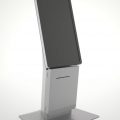A hot topic right now:
wearable tech that can identify your mood. There are a lot of obvious implications here. You could create a mood ring that actually works, for instance. A fashion brand recently produced fall-away clothing that goes to pieces when it detects arousal. And of course, the idea of a hat or a jacket that changes color or shape based on your mood sounds like a lot of fun, but there are other possibilities being explored, as well. To name a few…

-
Distress Calls
An example cited by a Washington Post story shows that wearable mood-reading technology can detect your mood and send it to your cell phone, where a distress call may be sent to your friends. Imagine the applications of this feature. If you’re in your room when someone breaks into your house and you can’t get to your phone, your friends might receive a signal that you’re scared.
If you’re injured or having a panic attack, your friends can call and talk you through it. Other applications might include something as simple as letting your friends know when you’re bored or feeling down so that they can come over and hang out to cheer you up.
-
Gaming
Affective computing offers a lot of new possibilities for game designers. Right now, there’s a lot of guesswork in game design, even as we learn more and more from aggregate data on how people play games. With affective computing, the game will be able to know when the player is getting bored and spawn some enemies for them to fight.
The game will be able to know what parts of the game the player likes best and give them more of that kind of content, or space it out and make them work for it so that it’s more rewarding. It’s not just video games, either. Movies will be able to detect the viewer’s mood and then play off of it, cutting and expanding scenes in real time. Music may be generated directly from the listener’s emotions.
“Now, when an artist finishes a work, the resulting piece doesn’t need to be set in stone, it can change and adapt to the audience like a theater troupe or a live musical performance.” Said technology expert.
-
Empathy Assistance
As referenced in the Washington Post article above, researchers used affective computing to help parents and caregivers of autistic children. The sensors provided vital clues to understanding and recognizing the child’s needs, so parents and caregivers could respond accordingly.
Wearable technology with mood sensors can be a big step forward for people who often find themselves ostracized not because they lack compassion, but because they fail to pick up on emotional cues and are unable to determine when someone else is upset, annoyed or angry. Furthermore, those with vision and/or hearing impairment or mental and emotional conditions may also be inept at interpreting others’ emotions.
On this note, imagine how many fights between married couples can be avoided when one spouse is wearing a “mood ring” that lets the other know, for sure, that they’re not just being passive aggressive or that they really aren’t just in a bad mood.
-
Health
One of the greatest advantages to affective computing will be its affect on the healthcare industry. Imagine a hospital bed that knows when a patient is uncomfortable, a medical bracelet that knows when you’re hungry, distressed or in pain. We often fret over how lazy people are getting with all of this automated technology, but it’s hard to argue that hands-free, automated, instantaneous medical service won’t do a lot more good than harm.
How many people have we lost to heart attacks because they couldn’t reach the phone in time? How much better could life in a hospital be for the infirmed if only we could know what they can’t always tell us?
At the end of the day, affective computing is just another kind of interface. It’s no different from a mouse or a keyboard, except that the input it takes is an instant reading of your mood. You can get the same effect by typing an angry email or Tweeting a positive commentary on a new movie. It’s just a quicker, better way of doing something that we’ve always been capable of doing.
Featured images:
License: Image author owned
About Author: Amy Taylor is a technology and business writer. Amy began her career as a small business owner in Phoenix, Arizona. She has taken that knowledge and experience and brought that to her unique writing capabilities. She really enjoys new business related issues that are tied directly to technology.






























No Comments
Leave a comment Cancel